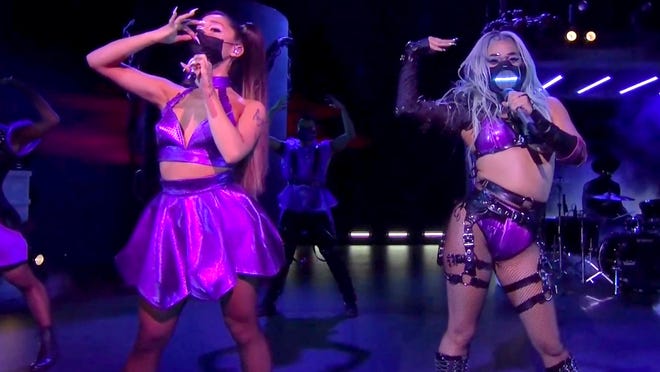Last week, the official word came: If you’re vaccinated, you can finally ditch your mask in certain social settings. One might expect the announcement to be met with waves of relief and an immediate shift in behavior. For some there was.
But others remain quietly hesitant — even though it’s safe, they don’t want to take off their masks yet.
According to new guidelines released last week by the Centers for Disease Control and Prevention, fully vaccinated Americans don’t need to wear a mask outside except in crowded settings, and can unmask during small outdoor gatherings with vaccinated people.
Masks have offered safety during unprecedented times. They were also divisive and often signaled to which political group you belonged, with studies showing that Republicans were less likely than Democrats to wear or believe in the efficacy of masks.
Wearing a mask meant you were adhering to the CDC and local mandates. The act of stripping off these masks will feel foreign and uneasy for some, and that reaction is not unexpected, experts say.
“Behaviors take time to implement and adopt. They also take time to un-adopt,” says Abraar Karan, an internal medicine physician at Brigham and Women’s Hospital. “Remember, it’s not an on and off switch.”
CDC guidelines:Fully vaccinated Americans don’t need to wear masks outside, except in crowded settings
Vaccinations:Why the Johnson & Johnson news feels so bad
‘Wearing a mask was one of the only forms of agency’ during the pandemic
Normalcy was shattered when the pandemic hit. The pandemic robbed us of control: We couldn’t control when we’d be able to return to our workplaces, when our children would be able to attend in-person school, when we’d be able to safely hug loved ones or when we’d resume gathering in large groups. At the start of the pandemic, with so many unknowns, it seemed we couldn’t even control whether we contracted the virus.
Then experts began recommending masks. Finally, we had agency.
“In the last year, we haven’t had much control, both in terms of the vaccine rollouts or testing done early in the pandemic or sending kids to school. But what everyone can actually control is putting that mask on,” says Peter Chin-Hong, an infectious disease specialist in San Francisco.
“It’s something everyone and anyone can do, and frankly something most people felt comfortable wearing.”
Coping with uncertainty:We all want to know how the coronavirus pandemic ends
People are scared to take a ‘risk’
Mike Bordieri, an associate professor of psychology at Murray State University, says it’s “predictable” that some people are hesitant to follow the updated guidelines, and their cautionary behavior can be explained by the psychological finding that humans often “overanalyze risk.”
Those who are concerned about the pandemic are more likely to seek out the latest information on news variants and global COVID-19 surges, which might lead to a stronger compulsion to wear a mask, he said.
Karan said the updated guidance may also present a struggle for those who have endured a traumatic experience linked to the pandemic, such as the loss of a loved one. People who suffer from mental health disorders may also struggle to adjust.
“People have already gone through so many losses and tragedies during the pandemic, so it makes sense that some people are wary of adopting these recent recommendations until they feel it out for themselves,” Karan says.
Ditching the pandemic ‘norm’ can be ‘stressful’
Nearly half of Americans say they feel uneasy thinking about in-person interaction once the pandemic ends, according to the American Psychological Association’s 2021 Stress in America report. And Sheriece Sadberry, a psychologist, says masks have served as a “natural barrier” for unwanted social encounters.
“You have some people who have enjoyed being able to keep distance from people,” Sadbery says. “It may suit their personality or be convenient for those who aren’t good at setting boundaries or enjoy the peace of having limited social interactions.”
Bordieri adds it might be stressful for those prone to anxiety or an intolerance to uncertainty to start thinking about how to acclimate to social settings as we start abandoning the masks.
“It’s burdensome and scary for some people to start thinking about how to meet new people, make new friends and adjust to this new society. And by keeping the masks, they can temporarily hold off on that,” Bordieri says.
Research shows after the pandemic ends there could be a rise in mental health conditions such as agoraphobia – an “irrational fear of being in open or unfamiliar places, resulting in the avoidance of public situations” – and obsessive-compulsive disorder – “characterized by recurrent intrusive thoughts (obsessions) that prompt the performance of neutralizing rituals (compulsions).”
Bordieri recommends taking things slowly to re-acclimate to pre-pandemic routines.
More:Why we’re scared for the pandemic to end
How to ease your transition back into the ‘real world’
Experts say it’s important to acknowledge your stress during this transition. It’s normal to feel nervous. Once people accept this, they can begin to take small steps toward re-integration with these tips:
- Remember it’s normal to feel stressed when being social again
- Prioritize who to hang out with first
- Designate time for self-care
- Know it’s OK to simply decline invitations
Contributing: Elise Brisco
